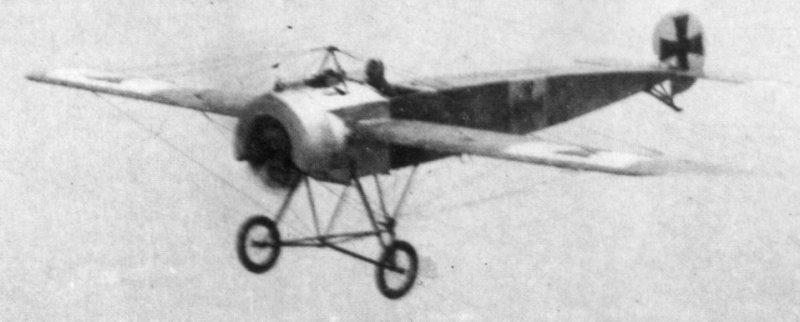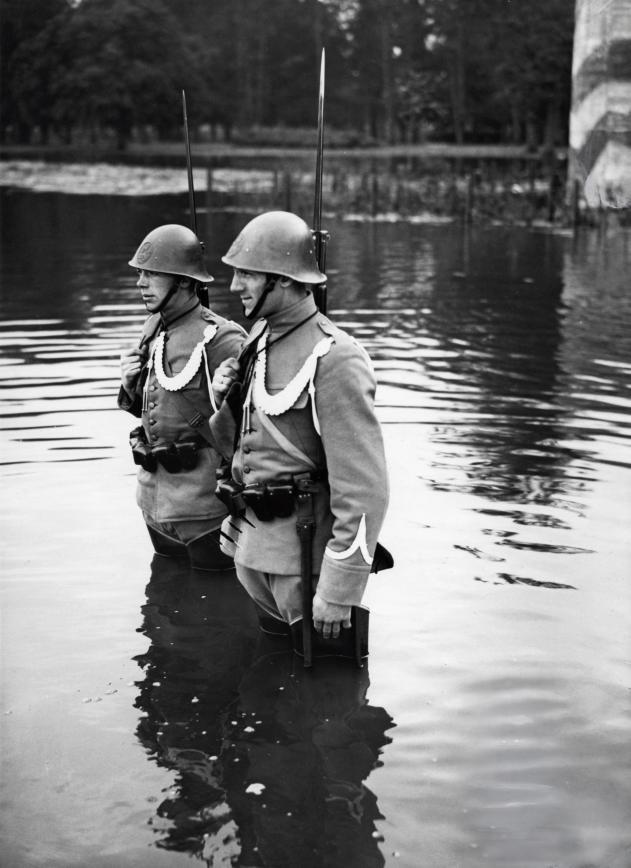|
Fokker D.XVII
Fokker D.XVII (sometimes written as Fokker D.17), was a 1930s Dutch sesquiplane developed by Fokker. It was the last fabric-covered biplane fighter they developed in a lineage that extended back to the First World War Fokker D.VII. Design and development Problems with severe vibration in the Armstrong Siddeley Jaguar radial engine on the Fokker D.XVI resulted in one being converted to use a normally aspirated Curtiss Conqueror V-1570 V-twelve, becoming the prototype for the D.XVII. Production versions were fitted with a Rolls-Royce Kestrel, while one aircraft was built with a Lorraine Pétrel and another was built with a Hispano-Suiza 12Xbrs for comparison purposes.Westburg, 1974, p.21 Structure was standard for Fokkers throughout the 1920s. The sesquiplane's fuselage was welded steel tube with fabric covering and the wings were made with wood spars and ribs covered with plywood.Davis, 1932, p.80 Operational history On 18 January 1935, Lieutenant René Wittert van Hoogla ... [...More Info...] [...Related Items...] OR: [Wikipedia] [Google] [Baidu] |
Fokker
Fokker was a Dutch aircraft manufacturer named after its founder, Anthony Fokker. The company operated under several different names. It was founded in 1912 in Berlin, Germany, and became famous for its fighter aircraft in World War I. In 1919 the company moved its operations to the Netherlands. During its most successful period in the 1920s and 1930s, it dominated the civil aviation market. Fokker went into bankruptcy in 1996, and its operations were sold to competitors. History Fokker in Germany At age 20, while studying in Germany, Anthony Fokker built his initial aircraft, the ''Spin'' (Spider)—the first Dutch-built plane to fly in his home country. Taking advantage of better opportunities in Germany, he moved to Berlin, where in 1912, he founded his first company, Fokker Aeroplanbau, later moving to the Görries suburb just southwest of Schwerin (at ), where the current company was founded, as Fokker Aviatik GmbH, on 12 February 1912. World War I Fokker capitalized o ... [...More Info...] [...Related Items...] OR: [Wikipedia] [Google] [Baidu] |
Fokker C
Fokker was a Dutch aircraft manufacturer named after its founder, Anthony Fokker. The company operated under several different names. It was founded in 1912 in Berlin, Germany, and became famous for its fighter aircraft in World War I. In 1919 the company moved its operations to the Netherlands. During its most successful period in the 1920s and 1930s, it dominated the civil aviation market. Fokker went into bankruptcy in 1996, and its operations were sold to competitors. History Fokker in Germany At age 20, while studying in Germany, Anthony Fokker built his initial aircraft, the ''Spin'' (Spider)—the first Dutch-built plane to fly in his home country. Taking advantage of better opportunities in Germany, he moved to Berlin, where in 1912, he founded his first company, Fokker Aeroplanbau, later moving to the Görries suburb just southwest of Schwerin (at ), where the current company was founded, as Fokker Aviatik GmbH, on 12 February 1912. World War I Fokker capitalized o ... [...More Info...] [...Related Items...] OR: [Wikipedia] [Google] [Baidu] |
Fokker Aircraft
Fokker was a Dutch aircraft manufacturer named after its founder, Anthony Fokker. The company operated under several different names. It was founded in 1912 in Berlin, Germany, and became famous for its fighter aircraft in World War I. In 1919 the company moved its operations to the Netherlands. During its most successful period in the 1920s and 1930s, it dominated the civil aviation market. Fokker went into bankruptcy in 1996, and its operations were sold to competitors. History Fokker in Germany At age 20, while studying in Germany, Anthony Fokker built his initial aircraft, the ''Spin'' (Spider)—the first Dutch-built plane to fly in his home country. Taking advantage of better opportunities in Germany, he moved to Berlin, where in 1912, he founded his first company, Fokker Aeroplanbau, later moving to the Görries suburb just southwest of Schwerin (at ), where the current company was founded, as Fokker Aviatik GmbH, on 12 February 1912. World War I Fokker capitalized on ... [...More Info...] [...Related Items...] OR: [Wikipedia] [Google] [Baidu] |
1930s Dutch Fighter Aircraft
Year 193 ( CXCIII) was a common year starting on Monday (link will display the full calendar) of the Julian calendar. At the time, it was known as the Year of the Consulship of Sosius and Ericius (or, less frequently, year 946 ''Ab urbe condita''). The denomination 193 for this year has been used since the early medieval period, when the Anno Domini calendar era became the prevalent method in Europe for naming years. Events By place Roman Empire * January 1 – Year of the Five Emperors: The Roman Senate chooses Publius Helvius Pertinax, against his will, to succeed the late Commodus as Emperor. Pertinax is forced to reorganize the handling of finances, which were wrecked under Commodus, to reestablish discipline in the Roman army, and to suspend the food programs established by Trajan, provoking the ire of the Praetorian Guard. * March 28 – Pertinax is assassinated by members of the Praetorian Guard, who storm the imperial palace. The Empire is auctioned off ... [...More Info...] [...Related Items...] OR: [Wikipedia] [Google] [Baidu] |
Autobiography Of An Engineer
An autobiography, sometimes informally called an autobio, is a self-written account of one's own life. It is a form of biography. Definition The word "autobiography" was first used deprecatingly by William Taylor in 1797 in the English periodical ''The Monthly Review'', when he suggested the word as a hybrid, but condemned it as "pedantic". However, its next recorded use was in its present sense, by Robert Southey in 1809. Despite only being named early in the nineteenth century, first-person autobiographical writing originates in antiquity. Roy Pascal differentiates autobiography from the periodic self-reflective mode of journal or diary writing by noting that " utobiographyis a review of a life from a particular moment in time, while the diary, however reflective it may be, moves through a series of moments in time". Autobiography thus takes stock of the autobiographer's life from the moment of composition. While biographers generally rely on a wide variety of documents a ... [...More Info...] [...Related Items...] OR: [Wikipedia] [Google] [Baidu] |
Curtiss P-6 Hawk
The Curtiss P-6 Hawk is an American single-engine biplane fighter introduced into service in the late 1920s with the United States Army Air Corps and operated until the late 1930s prior to the outbreak of World War II. Design and development The Curtiss Aeroplane and Motor Company (which became the Curtis-Wright Corporation (15 July 1929) supplied the USAAC with P-6s beginning in 1929. Operational history A fast and highly maneuverable aircraft for its time, the XP-6 prototype took 2nd place in the 1927 U.S. National Air Races, and the XP-6A with wing surface radiators took first place, at 201 mph (323 km/h). The P-6 was flown in a variety of paint schemes depending on the squadron, the most famous being the "Snow Owl" markings of the 17th Pursuit Squadron based at Selfridge Field near Detroit, Michigan. The P-6Es served between 1932 and 1937 with the 1st Pursuit Group (17th and 94th PS) at Selfridge, and with the 8th Pursuit Group (33rd PS) at Langley Field, Vi ... [...More Info...] [...Related Items...] OR: [Wikipedia] [Google] [Baidu] |
Hawker Fury
The Hawker Fury is a British biplane fighter aircraft used by the Royal Air Force in the 1930s. It was a fast, agile aircraft, and the first interceptor in RAF service capable of speed higher than 200 mph (321 kmh). It was the fighter counterpart to the Hawker Hart light bomber. Design and development The Hawker Fury was a development of the earlier Hawker F.20/27 prototype fighter, replacing the radial engine of the F.20/27 with the new Rolls-Royce F.XI V-12 engine (later known as the Rolls-Royce Kestrel), which was also used by Hawker's new light bomber, the Hawker Hart. The new fighter prototype, known as the Hawker Hornet, first flew at Brooklands, Surrey, in March 1929.Mason 1992, p.213. The Hornet was a single-engined biplane, with single bay wings, initially powered by a 420 hp (313 kW) Rolls-Royce F.XIC engine enclosed by a smooth, streamlined cowling but was quickly re-engined with a 480 hp (358 kW) Kestrel IS.Goulding 1986, p.37. The prototyp ... [...More Info...] [...Related Items...] OR: [Wikipedia] [Google] [Baidu] |
Royal Netherlands East Indies Army
The Royal Netherlands East Indies Army ( nl, Koninklijk Nederlands Indisch Leger; KNIL, ) was the military force maintained by the Kingdom of the Netherlands in its colony of the Dutch East Indies, in areas that are now part of Indonesia. The KNIL's air arm was the Royal Netherlands East Indies Army Air Force. Elements of the Royal Netherlands Navy and Government Navy were also stationed in the Netherlands East Indies. History 1814–1942 The KNIL was formed by royal decree on 14 September 1814. It was not part of the Royal Netherlands Army, but a separate military arm specifically formed for service in the Netherlands East Indies. Its establishment coincided with the Dutch drive to expand colonial rule from the 17th century area of control to the far larger territories constituting the Dutch East Indies seventy years later. The KNIL was involved in many campaigns against indigenous groups in the area including the Padri War (1821–1845), the Java War (1825–1830), crushin ... [...More Info...] [...Related Items...] OR: [Wikipedia] [Google] [Baidu] |
Neville Shute Norway
Nevil Shute Norway (17 January 189912 January 1960) was an English novelist and aeronautical engineer who spent his later years in Australia. He used his full name in his engineering career and Nevil Shute as his pen name, in order to protect his engineering career from inferences by his employers (Vickers) or from fellow engineers that he was '"not a serious person" or from potentially adverse publicity in connection with his novels, which included '' On the Beach'' and ''A Town Like Alice''. Early life Shute was born in Somerset Road, Ealing (which was then in Middlesex), in the house described in his novel '' Trustee from the Toolroom''. He was educated at the Dragon School, Shrewsbury School and Balliol College, Oxford; he graduated from Oxford in 1922 with a third-class degree in engineering science. Shute's father, Arthur Hamilton Norway, became head of the Post Office in Ireland before the First World War and was based at the General Post Office, Dublin in 1916 at th ... [...More Info...] [...Related Items...] OR: [Wikipedia] [Google] [Baidu] |
Airspeed Ltd
Airspeed Limited was established in 1931 to build aeroplanes in York, England, by A. H. Tiltman and Nevil Shute Norway (the aeronautical engineer and novelist, who used his forenames as his pen-name). The other directors were A. E. Hewitt, Lord Grimthorpe and Alan Cobham. Amy Johnson was also one of the initial subscribers for shares. Foundation Airspeed Ltd. was founded by Nevil Shute Norway (later to become a novelist as Nevil Shute) and designer Hessell Tiltman. In his autobiography, '' Slide Rule: Autobiography of an Engineer'', Norway gives an account of the founding of the company and of the processes that led to the development and mass production of the Oxford. He received the Fellowship of the Royal Aeronautical Society for his innovative fitting of a retractable undercarriage to aircraft. Early operations The AS.1 Tern, the first British high-performance glider (sailplane), was built to get publicity, and attract more capital, by setting British gliding records. ... [...More Info...] [...Related Items...] OR: [Wikipedia] [Google] [Baidu] |
German Army (Wehrmacht)
The German Army (, "army") is the land component of the armed forces of Federal Republic of Germany, Germany. The present-day German Army was founded in 1955 as part of the newly formed West German ''Bundeswehr'' together with the German Navy, ''Marine'' (German Navy) and the German Air Force, ''Luftwaffe'' (German Air Force). , the German Army had a strength of 62,766 soldiers. History Overview A German army equipped, organized, and trained following a single doctrine and permanently unified under one command in 1871 during the unification of Germany under the leadership of Prussia. From 1871 to 1919, the title ''German Army (German Empire), Deutsches Heer'' (German Army) was the official name of the German land forces. Following the German defeat in World War I and the end of the German Empire, the main army was dissolved. From 1921 to 1935 the name of the German land forces was the ''Reichswehr, Reichsheer'' (Army of the Empire) and from 1935 to 1945 the name ''German Army (We ... [...More Info...] [...Related Items...] OR: [Wikipedia] [Google] [Baidu] |
Battle Of The Netherlands
The German invasion of the Netherlands ( nl, Duitse aanval op Nederland), otherwise known as the Battle of the Netherlands ( nl, Slag om Nederland), was a military campaign part of Battle of France, Case Yellow (german: Fall Gelb), the Nazi Germany, Nazi German invasion of the Low Countries (Belgium, Luxembourg, and the Netherlands) and French Third Republic, France during World War II. The battle lasted from 10 May 1940 until the surrender of the main Dutch forces on 14 May. Dutch troops in the province of Zeeland continued to resist the ''Wehrmacht'' until 17 May when Germany completed its occupation of the whole country. The invasion of the Netherlands saw some of the earliest mass paratroop drops, to occupy tactical points and assist the advance of ground troops. The German ''Luftwaffe'' used paratroopers in the capture of several airfields in the vicinity of Rotterdam and The Hague, helping to quickly overrun the country and immobilise Dutch forces. After the devastating ... [...More Info...] [...Related Items...] OR: [Wikipedia] [Google] [Baidu] |







.jpg)

